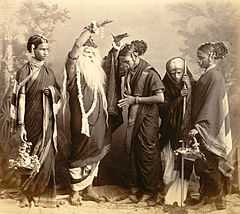Marathi theatre

| Part of a series on the |
| Culture of Maharashtra |
|---|
|
Traditions
|
| Religion |
|
Art
|
|
|
|
Music and performing arts |
|
Media
|
|
Sport
|
|
Marathi theatre is theatre in Marathi-language, mostly originating or based in the state Maharashtra in India, and elsewhere with Marathi diaspora. Starting in the middle of the 19th century, it flourished in the 1950s and 60s, and includes forms like Sangeet Natak (Musical drama) and Tamasha (folk dance). Today, it continues to have a marked presence in the State of Maharashtra with a loyal audience base, when most theatre in other parts of India have had tough time facing the onslaught of cinema and television. Its repertoire ranges from humorous social plays, farces, historical plays, musical, to experimental plays and serious drama of the 1970s onwards, by Vijay Tendulkar, P. L. Deshpande, Mahesh Elkunchwar and Satish Alekar, which have influenced theatre throughout India.[1] In fact in the post-independence era, besides Bengali theatre, Marathi theatre has been a singular driving force behind innovations and significant dramaturgy in Indian theatre.[2]
History
The region of Maharashtra, has had long theatrical tradition, one of early references are found the cave inscriptions at Nashik by Gautami Balashri, the mother of 1st-century Satavahana ruler, Gautamiputra Satakarni. The inscription mention him organizing Utsava and Samaja, forms of theatrical entertainment for his subjects.[3]
Though there have been references of 17th-century plays, like Lakshmaikalyanam in Marathi-language staged for the Bhosale ruler of Tanjore in present Tamil Nadu state, they were court plays. Thus the first public performance of a stage play in Marathi was Sita Swayamvar (Marriage of Sita) by Vishnudas Bhave, based on a popular episode of epic Ramayana. Staged in 1843 in Sangli, with ruler the princely state of Sangli in audience, it was an experimental play, based folk theatre form, Yakshagana from the neighbouring Karnataka state. After the success of his play, we staged many more plays about other episodes of Ramayana largely influenced by Shakespearean theatre and Parsi theatre, and went on form a travelling theatre troupe.[4][5] The coming decades saw notable plays like Jhansichya Raniche Naatak (1870), Sawai Madhavravancha Mrutyu (1871), AfjhalKhanachya Mrutyuche Naatak (1871) and Malharrav Maharaj (1875). However it took a distinct theatre form with the musical Shakuntal by Annasaheb Kirloskar in 1880, again based on a classical work, Abhijnanasakuntalam by Kalidasa. The success of his theatre company, Kirloskar Natya Mandali paved way for commercial repertories in Marathi theatre, and subsequently the formation of Natak Companies.[6]
The early period of Marathi theatre was dominated by playwrights like Kolhatkar, Krushnaji Prabhakar Khadilkar, Govind Ballal Deval, Ram Ganesh Gadkari and Annasaheb Kirloskar who enriched the Marathi theatre for about half a century with excellent musical plays known as Sangeet Natak. The genre of music used in such plays is known as Natya Sangeet. It is during this era of the Marathi theatre that great singer-actors like Bal Gandharva, Keshavrao Bhosle, Bhaurao Kolhatkar and Deenanath Mangeshkar thrived.
Theatre director, Vijaya Mehta introduced Bertold Brecht into Marathi theatre with adaptation of The Caucasian Chalk Circle (Ajab Nyay Vartulacha),
Over the years, some modern theatre practitioners have incorporated the traditional forms like tamasha and dashavatar into their plays. In the 1970s, the tamasha form was employed as narrative device and style in several notable plays like Ghashiram Kotwal by Vijay Tendulkar, Vijaya Mehta's Marathi adaptations of Bertolt Brecht's The Good Woman of Setzuan as Devajine Karuna Keli (1972) and Caucasian Chalk Circle as Ajab Nyaya Vartulacha (1974), P. L. Deshpande's Teen paishacha Tamasha (1978), an adaptation of Brecht's The Threepenny Opera. Mehta also adapted and Ionesco with Chairs.[7][8]
See also
- Theatre in India
Bibliography
- Anand Patil (1993). Western influence on Marathi drama: a case study. Rajahaṃsa. ISBN 81-85854-06-8.
- Dnyaneshwar Nadkarni (1988). Balgandharva and the Marathi theatre. Roopak Book.
- Shanta Gokhale; National School of Drama (2000). Playwright at the Centre: Marathi drama from 1843 to the present. Seagull Books. ISBN 81-7046-157-X.
- Shanta Gokhale (2008). "Mapping Marathi theatre". india-seminar.
Notes
References
- Stanley Hochman (1984). McGraw-Hill encyclopedia of world drama (Vol. 3). VNR AG. ISBN 0-07-079169-4.
- Manohar Laxman Varadpande (1992). History of Indian Theatre. Abhinav Publications. ISBN 978-81-7017-278-9.
- Don Rubin (1998). The World Encyclopedia of Contemporary Theatre: Asia. Taylor & Francis. ISBN 0-415-05933-X.
- Amaresh Datta (2006). The Encyclopaedia Of Indian Literature (Vol. 2). Sahitya Akademi. ISBN 81-260-1194-7.
- Gabrielle H. Cody; Evert Sprinchorn (2007). The Columbia encyclopedia of Modern Drama, (Vol. 1). Columbia University Press. ISBN 0-231-14422-9.
- Aparna Bhargava Dharwadker (2009). Theatres of Independence: Drama, Theory, and Urban Performance in India Since 1947. University of Iowa Press. ISBN 978-1-58729-642-0.
External links
| ||||||||||||||||||||||||||||||